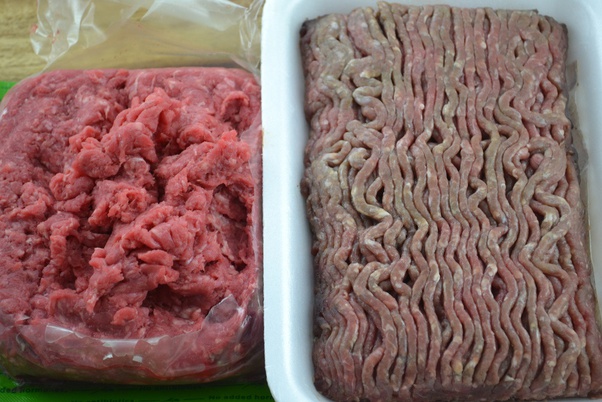Tips
By correctly and safely handling and storing ground beef, people should be able to avoid spoilage. It is important for people to be aware of potential signs that may indicate spoilage, such as color, smell, texture, and compromised packaging or storage.
In addition to safe handling and storage of ground beef, people should also ensure they thoroughly cook ground beef to the correct internal temperature to destroy bacteria.
Ground beef is a versatile meat that may be a staple item in many people’s diets. But it is likely to go bad faster than other cuts of meat, which can ruin the taste and make people sick. People should pay close attention to the color, texture, smell, and expiration date of ground beef.
Ground beef is a popular food in the United States. Research estimates that around 62%Trusted Source of all beef sold in the U.S. is ground. But the process of grinding meat exposes a larger surface area of ground beef to potentially harmful bacteria. This means it is likely to go bad faster than other cuts of beef.
Two examples of bacteria that may affect ground beef are spoilage bacteria and pathogenic bacteria. Spoilage bacteria are not generally harmful but will cause food to lose quality. This may cause unpleasant odors or tastes. Pathogenic bacteria are more dangerous. They may contaminate food and cause a foodborne illness rested the Source, which can result in food poisoning.
In this article, we will discuss signs to look out for to tell if ground beef is bad and provide tips on how to safely handle and store ground beef.
How to tell if ground beef is bad
Consuming spoiled or undercooked beef can make people feel sick, so individuals should try to store, handle, and prepare beef safely to prevent them from getting ill. There are signs people can be aware of that may warn them that ground beef is now bad.
Color
One quick way to determine if ground beef has spoiled or is good to eat is by looking at the color of the meat. Good quality, unspoiled ground beef bought from the supermarket should be bright red on the outside.
This is due to oxygen from the air reacting with meat pigments called oxymyoglobin to form a bright red color on the surface of the meat. Oxymyoglobin is typically the red liquid that leaks out of meat that many people may mistake for blood.
The inside of the meat will likely not have reacted with oxygen, so maybe grayish-brown in color, but is still perfectly fine to eat.
But if the ground beef is gray or brown on the outside surface of the meat, people should discard it. This discoloration suggests that it has started to go bad.
If a person notices mold on the surface of their ground beef, they should throw it away immediately, whether it be raw or cooked.
Texture
People can also check the texture to see if meat is bad. Ground beef that is fine to consume should have a relatively firm consistency that breaks apart when a person squeezes it.
But a sticky or slimy texture may indicate the presence of spoilage bacteria. This may be the result of ropy slime-forming bacteria. This bacteria can release volatile compounds that may cause slime to form on the surface of the meat.
To avoid potentially spreading bacteria, it is advisable for people to thoroughly wash their hands after handling raw meat.
Smell
Another way to tell if ground beef has gone bad is by simply smelling it. Normal, safe, fresh ground beef should not have a noticeable or unpleasant smell. Multiplying spoilage bacteria can cause a strong door trusted Source to occur.
But it is important to remember that pathogenic bacteria may not cause a bad smell. So if there is not a bad scent but the ground beef is displaying other signs that it has gone bad, it is still advisable to discard the meat.
Expiration date
The Food and Drug Administration (FDA)Trusted Source does not require there be an expiration date label on any food products except infant formula. But because there are localized rules surrounding these dates, most food products do tend to have a date on them.
While many products may feature a “best before” label, the FDA wants to dispel confusion rested Source and instead use the term “best if used by.” Labels such as “best before” simply refer to how long the product is likely to keep its quality and flavor, not safe.
As long as a person correctly and safely storesTrusted Source their meat, they do not necessarily need to discard any products past their “best before” date. It is safe for people to consume refrigerated ground beef up to 2 days past this date. If freezing, it is advisable to eat ground beef within 4 monthsTrusted Source.
But if a person has not correctly or safely stored meat, it is not advisable to eat it beyond the “best before” date. If a person has stored the meat at too high a temperature, or the packaging is torn or leaking, it is possible that bacteria has contaminated the ground beef.
Side effects of eating bad beef
People should be cautious if they suspect that ground beef may be bad. By consuming potentially spoiled meat, people run the risk of developing food poisoning.
Symptoms of food poisoning may include trusted Source:
- abdominal cramps
- diarrhea
- fever
- nausea
- upset stomach
- vomiting
- bloody stools
- dehydration
OutbreaksTrusted Source of food poisoning linked to ground beef is a relatively common trusted Source in the U.S.
Bacteria that may cause these outbreaks to include SalmonellaTrusted Source, Escherichia coli (E. coli)Trusted Source, or CampylobacterTrusted Source. While many infections resulting from these bacteria can be mild, in some cases they can be life threateningTrusted Source.
































